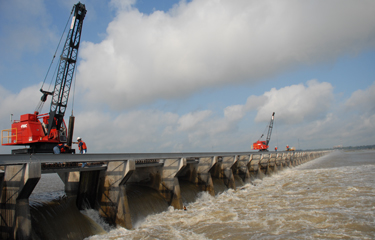The U.S. Army Corps of Engineers opened the Bonnet Carré Spillway on Friday, 3 April, marking the first time in history the flood control system for the Lower Mississippi Valley has been opened for three consecutive years.
The release of freshwater from the river and the pollutants it carries into the saltwater Gulf of Mexico have devastated oyster, shrimp, and other fisheries, leading to U.S. Commerce Secretary Wilbur Ross to approve disaster declarations for Alabama, Louisiana and Mississippi.
Major General Mark Toy, the commanding general for the Corps' Mississippi Valley Division, said since September the Upper Mississippi Valley has experienced one of its wettest periods on record, with the water now making its way downstream.
That prompted him to make the decision to open the spillway. Toy noted he spoke with the governors of both Mississippi and Louisiana to notify them, and before that, he said that stakeholder meetings were held this past week, giving people a chance to voice concerns as Corps officials were contemplating the decision.
“To the people who are affected by the opening of the spillway, I ask you to understand that we do this to help save lives, to protect people,” Toy said.
Colonel Stephen Murphy, the Corps district commander for New Orleans, said at a Friday press conference the freshwater release is expected to be less this year than during the first of last year’s two openings.
The first opening last year started in 27 February and lasted 43 days, with a maximum release of 213,000 cubic feet of water released per second. The release starting Friday is expected to last about four weeks, with the top flow of about 130,000 cubic feet per second.
That’s still little comfort to fishermen in the Gulf of Mexico. Mississippi Commercial Fisheries United Director Ryan Bradley told SeafoodSource on Friday that one million adult oysters from Texas were just placed in the water two weeks ago to replenish what was lost last year.
This is also the time for juvenile brown shrimp to emerge from the estuaries. Bradley expressed concern that the freshwater discharge could kill the shrimp or flush them out.
“If this thing goes on more than three weeks, we're going to have a very severe destruction to our marine life seafood industry,” Bradley told SeafoodSource.
Bradley said the releases from the Bonnet Carré spillway have caused more than USD 500 million (EUR 463.6 million) in damage to the seafood industry in the three states combined. The spillway disasters, which date back nearly a decade, are also causing people Bradley knows in the business to look for other work.
It also comes at a time when the coronavirus pandemic is starting to have an impact on what’s available at supermarkets.
“Beef, chicken, poultry is getting hard to find down here, and we're going to look to become very dependent on our local marine resources,” he said. “Our shrimp, our fish our crabs and with this spillway opening, it has a very real effect.”
Photo courtesy of Wikimedia Commons







